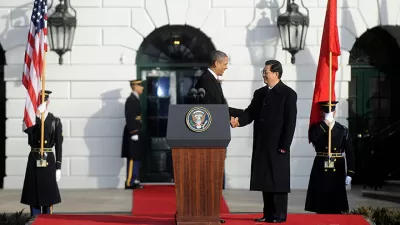I am sorry to report that, Canada, my chosen country (I immigrated here in 1993), recently withdrew from the Kyoto Accord, which sets international climate change emission reduction targets. It’s worth noting that this decision was made...
I am sorry to report that, Canada, my chosen country (I immigrated here in 1993), recently withdrew from the Kyoto Accord, which sets international climate change emission reduction targets. It's worth noting that this decision was made by the ruling Conservative Party which received less than 40% of total votes, but the other four parties split the more progressive votes and are unable to form a coalition, resulting in federal policies that are far more politically conservative than the average Canadian would prefer.
Climate change is a wicked problem because it involves a complex mix of differing values and perspectives, plus a high degree of uncertainty, so there is no single "correct" solution. However, this does not reduce the justification for action. Many planning decisions involve diverse perspectives and uncertainty, and there are normal ways to address these factors. In particular, decision-makers can implement no regrets actions that reduce risks with minimal costs and maximum co-benefits.
The most common objection to emission reduction targets is that they are economically harmful. However, this is not necessarily true. There are many no-regrets or win-win strategies that can reduce emissions and support economic development. Many of these involve policy reforms that increase transport system efficiency. Let me explain.
Theory
According to economic theory, an efficient market must reflect the following principles:
· Consumer options (also called consumer sovereignty). Consumers need viable options and information about those options, so they can choose the combination of goods that best meets their needs.
· Cost-based pricing. Prices should reflect costs as much as possible. There should be no significant external costs unless specifically justified.
· Economic neutrality. Public policies (laws, taxes, subsidies, and investment policies) should apply equally to comparable goods and users.
These principles apply to transport and land use "markets," which includes the supply, design, pricing and management of facilities (sidewalks, paths, roads), inputs (vehicles and fuel), and locations (land use development patterns). Inadequate transport options, underpricing of transport inputs, and planning practices that unintentionally favor automobile travel over more resource-efficient modes tend to reduce economic efficiency. Policy reforms that correct these distortions tend to both support economic development and reduce pollution emissions.
Below are examples of win-win emission reduction strategies:
- Remove Petroleum Production Subsidies
- Distance-Based Vehicle Insurance and Registration Fees
- Least-Cost Transportation Planning
- Prioritizing Transportation
- Revenue-Neutral Tax Shifting
- Efficient Road Pricing
- Smart Growth Development Policies
- More Flexible Zoning Requirements
- Efficient Parking Pricing and Parking Cash Out
- Mobility Management Marketing
- Freight Transport Management
- Location Efficient Development and Mortgages
- School and Campus Transport Management Programs
- Carsharing
- Transit Improvements
- Nonmotorized Transport Improvements
- Traffic Calming and Traffic Speed Reductions
- Road Space Reallocation
Although individually most of these strategies have only modest impacts, reducing just a few percent of total vehicle travel and emissions, their impacts are cumulative and synergistic (implemented together their total impacts are greater than the sum of their individual impacts). My analysis indicates that if implemented to the degree justified by economic principles these win-win strategies would reduce per capita vehicle travel, fuel consumption and pollution emissions by 25-50% compared with what currently occurs, while increasing overall economic productivity and consumer welfare. Although such policies would cause some industries (petroleum and vehicle production) to contract, this would be more than offset by expansion in other industries.
This is not to deny that motor vehicle travel contributes to many productive activities, allowing industries to ship goods, business people to attend meetings, plumbers and electricians to efficiently provide their services, and commuters to reach worksites and schools. However, in many situations this access could be achieved in more resource efficient ways – using more fuel efficient vehicles, more resource efficient modes, more accessible locations, and mobility substitutes such as telework and delivery services - but this only occurs if travelers have better options and incentives.
Conventional economists tend to support these reforms, but use a narrow analysis framework that undervalues their total benefits. For example, most economists recognize that road use underpricing causes traffic congestion; that parking underpricing increases parking facility costs; and emission underpricing leads to economically excessive pollution damages, but they generally overlook their cumulative effects: by increasing total vehicle travel underpricing road use not only increases congestion, it also increases parking costs, accidents and air pollution. Similarly parking underpricing exacerbates traffic congestion, accidents and pollution problems. Described more positively, most transport pricing and planning reforms can help achieve a variety of planning objectives. As a result of these co-benefits, such reforms usually provide far greater total benefits than most economic evaluations indicate. More comprehensive economic analysis tends to support win-win emission reduction strategies.
Empirical Evidence
There is plenty of empirical evidence that, beyond an optimal level, excessive motor vehicle travel reduces economic productivity, and that mobility management and smart growth policies tend to support economic development. For example, Figure 1 shows that, among U.S. states, those with higher per capita vehicle travel tend to have lower per capita GDP.
Figure 1 Per Capita GDP and VMT For U.S. States
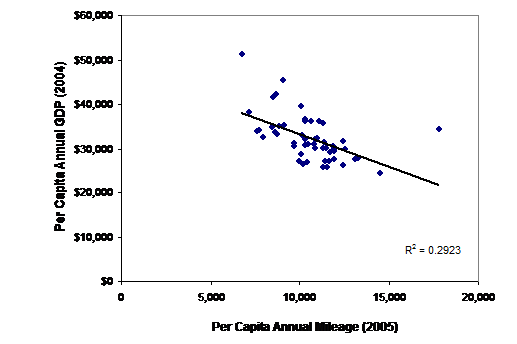
Per capita economic productivity increases as vehicle travel declines. (Each dot is a U.S. state.)
Similarly, GDP tends to increase with public transit travel, as illustrated in Figure 2.
Figure 2 Per Capita GDP and Transit Ridership

GDP tends to increase with per capita transit travel. (Each dot is a U.S. urban region.)
Per capita GDP also tends to increase with population density, as illustrated in Figure 3. This indicates agglomeration efficiencies, due to the economic efficiency gains that result from improved land use accessibility (reduced distances between activities).
Figure 3 Per Capita GDP and Urban Density
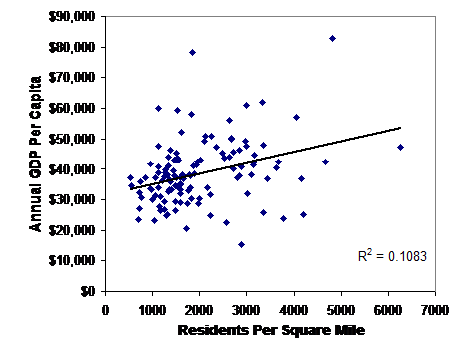
Productivity tends to increase with population density. (Each dot is a U.S. urban region.)
Figure 4 shows how per capita GDP tends to increase with automobile mode share up to peak, beyond which it declines, and how this peak varies from one region to another.
Figure 4 Automobile Mode Share Versus GDP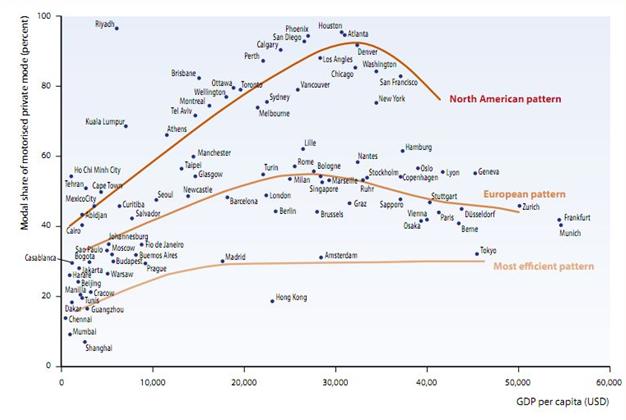 Many of the world's wealthiest cities have relatively low automobile mode share.
Many of the world's wealthiest cities have relatively low automobile mode share.
Figure 5 shows that per capita GDP increases with fuel prices, particularly among oil importing countries ("Oil Consumers"). This suggests that, contrary to popular belief, high fuel prices (and therefore, high vehicle operating costs) increase economic productivity and development by increasing transport system efficiency and reducing the wealth lost to importing fuel.
Figure 5 GDP Versus Fuel Prices By Countries
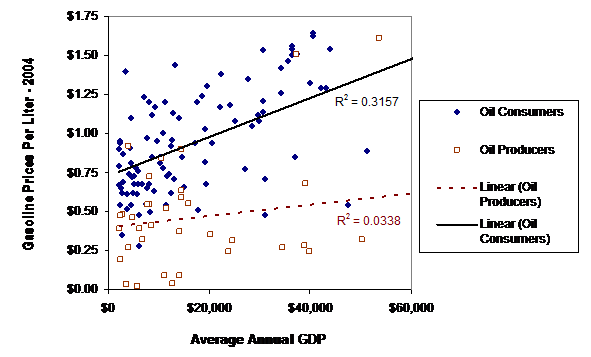
Economic productivity tends to increase with higher fuel prices, indicating that substantial increases in vehicle fees can be achieved without reducing overall economic productivity.
Norway is a good example of a country that uses efficient transport policies to support economic development. It is a petroleum producer but maintains high fuel prices and has other mobility management policies to support efficient modes. These policies minimized domestic fuel consumption, leaving more oil to export, which increases national wealth. As a result, Norway has one of the world's highest incomes, a competitive and expanding economy, a positive trade balance, and the world's largest legacy fund. Other petroleum-producing countries, such as Saudi Arabia, Nigeria, Venezuela, and the United States, maintain low fuel prices and automobile-dependent transport planning practices which leads to economically inefficient vehicle travel and fuel consumption, reducing productivity – what some economists call a resource curse.
Importance To Planners
These issues are important to planners. Many local, regional, state and national governments have various economic, social and environmental objectives that must be reconciled. It is generally best to implement strategies that help achieve multiple objectives, rather than addressing each individually. We need good analysis to identify the true win-win solutions, and negotiate with stakeholders to overcome the inevitable political obstacles.
We shouldn't be simplistic about these issues. Certainly, some policy and planning decisions involve trade-offs between economic development and environmental protection objectives, and not every win-win solution is appropriate everywhere. But this research does indicate that many win-win emission reduction strategies can help achieve emission reduction and economic development targets. This is an opportunity for planners to help their communities find the truly optimal solutions, considering all objectives and impacts.
For More Information
Asian Cobenefits Partnership (http://www.cobenefit.org ) is a coalition that supports mainstreaming co-benefits into sectoral development plans, policies and projects in Asia.
Cambridge Systematics (2009), Moving Cooler: Transportation Strategies to Reduce Greenhouse Gas Emissions (www.movingcooler.info), co-sponsored by a variety of organizations; report at http://commerce.uli.org/misc/movingcooler.pdf; summary at http://commerce.uli.org/misc/movingcoolerexecsum.pdf.
Lawrence D. Frank, et al. (2010), "Carbonless Footprints: Promoting Health and Climate Stabilization Through Active Transportation," Preventive Medicine, Vol. 50, Supplement 1, pp. S99-S105; at www.activelivingresearch.org/resourcesearch/journalspecialissues.
IGES (2011), Mainstreaming Transport Co-Benefits Approach: A Guide To Evaluating Transport Projects, Institute for Global Environmental Strategies (www.iges.or.jp); at www.iges.or.jp/en/cp/pdf/co-benefits/Transport%20Co-benefits%20Guidelines.pdf.
Chuck Kooshian and Steve Winkelman (2011), Growing Wealthier: Smart Growth, Climate Change and Prosperity, Center for Clean Air Policy (www.ccap.org); at www.growingwealthier.info.
Todd Litman (1999), "Exploring the Paradigm Shifts Needed to Reconcile Transportation and Sustainability Objectives," Transportation Research Record 1670, Transportation Research Board (www.trb.org), pp. 8-12; at www.vtpi.org/reinvent.pdf.
Todd Litman (2006), Win-Win Transportation Solutions: Cooperation for Economic, Social and Environmental Benefits, Victoria Transport Policy Institute (www.vtpi.org); at www.vtpi.org/winwin.pdf.
Todd Litman (2006), "Transportation Market Distortions," Berkeley Planning Journal; issue theme Sustainable Transport in the United States: From Rhetoric to Reality? (www-dcrp.ced.berkeley.edu/bpj), Volume 19, 2006, pp. 19-36; at www.vtpi.org/distortions_BPJ.pdf.
Todd Litman (2008), Smart Transportation Emission Reduction Strategies, VTPI (www.vtpi.org); at www.vtpi.org/ster.pdf.
Todd Litman (2009), Are Vehicle Travel Reduction Targets Justified? Evaluating Mobility Management Policy Objectives Such As Targets To Reduce VMT And Increase Use Of Alternative Modes, Victoria Transport Policy Institute (www.vtpi.org); at www.vtpi.org/vmt_red.pdf.
G. F. Nemet, T. Holloway and P. Meier (2010) "Implications Of Incorporating Air-Quality Co-Benefits Into Climate Change Policymaking," Environmental Research Letters (http://iopscience.iop.org/1748-9326/5/1/014007); at http://iopscience.iop.org/1748-9326/5/1/014007/pdf/1748-9326_5_1_014007.pdf.
Scott Sharpe and Paul Tranter (2010), "The Hope For Oil Crisis: Children, Oil Vulnerability And (In)Dependent Mobility," Australian Planner, Vol. 47, No. 4, December, pp. 284-292; summary at www.informaworld.com/smpp/content~db=all~content=a930689553~frm=abslink.
WHO (2011), Health Co-Benefits Of Climate Change Mitigation - Transport Sector: Health In The Green Economy, Health Impact Assessment, World Health Organization (www.who.int/hia); at www.who.int/hia/examples/trspt_comms/transport_sector_health_co-benefits_climate_change_mitigation/en/index.html.
Lloyd Wright (2009), Win-Win Solutions and Climate Change and Transport, United Nations Centre for Regional Development (www.uncrd.org.jp); at www.uncrd.or.jp/env/4th-regional-est-forum/Presentations/01_PS1_Wright.pdf.

Planetizen Federal Action Tracker
A weekly monitor of how Trump’s orders and actions are impacting planners and planning in America.

Maui's Vacation Rental Debate Turns Ugly
Verbal attacks, misinformation campaigns and fistfights plague a high-stakes debate to convert thousands of vacation rentals into long-term housing.

Restaurant Patios Were a Pandemic Win — Why Were They so Hard to Keep?
Social distancing requirements and changes in travel patterns prompted cities to pilot new uses for street and sidewalk space. Then it got complicated.

In California Battle of Housing vs. Environment, Housing Just Won
A new state law significantly limits the power of CEQA, an environmental review law that served as a powerful tool for blocking new development.

Boulder Eliminates Parking Minimums Citywide
Officials estimate the cost of building a single underground parking space at up to $100,000.

Orange County, Florida Adopts Largest US “Sprawl Repair” Code
The ‘Orange Code’ seeks to rectify decades of sprawl-inducing, car-oriented development.
Urban Design for Planners 1: Software Tools
This six-course series explores essential urban design concepts using open source software and equips planners with the tools they need to participate fully in the urban design process.
Planning for Universal Design
Learn the tools for implementing Universal Design in planning regulations.
Heyer Gruel & Associates PA
JM Goldson LLC
Custer County Colorado
City of Camden Redevelopment Agency
City of Astoria
Transportation Research & Education Center (TREC) at Portland State University
Jefferson Parish Government
Camden Redevelopment Agency
City of Claremont




























